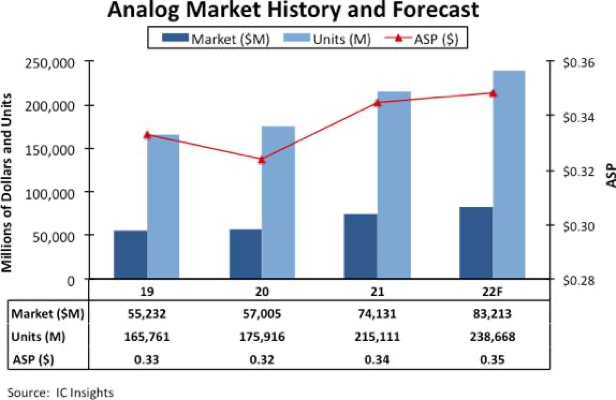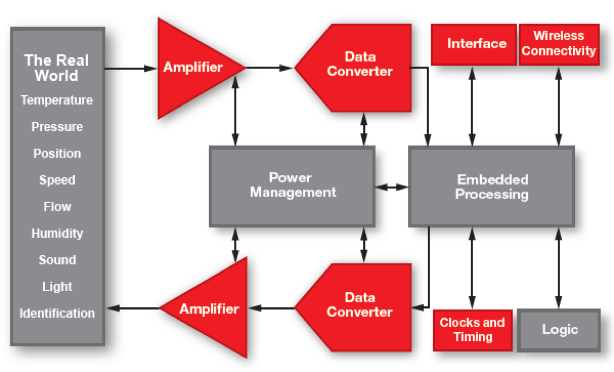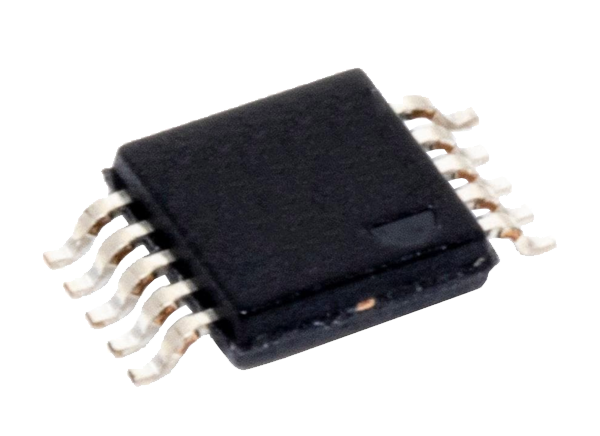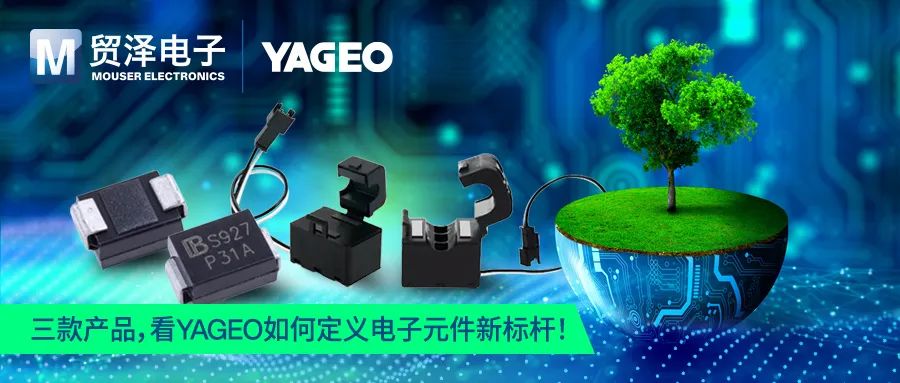 Image Source: Sashkin/stock.adobe.com
Image Source: Sashkin/stock.adobe.comIn June of this year, the semiconductor industry released two noteworthy pieces of news:

Figure 1: Analog Market Sales Situation and 2022 Forecast
(Image Source: IC Insights)
Due to the remarkable growth in both momentum and breadth, last year’s analog IC market is likely to be a memorable one. Data from IC Insights shows that the total sales of the entire analog market reached a historic high of $74.1 billion in 2021. Among them, the top ten global analog product suppliers accounted for 68% of the sales. Strong demand combined with supply chain disruptions led to a 6% increase in the average selling price (ASP) of analog ICs last year. Before this, the ASP of analog products had not increased for 17 years since 2004. In 2022, every major general-purpose and specific application analog market category tracked by IC Insights is expected to see sales growth, with sub-markets such as amplifiers and comparators growing by about 7%, and automotive-specific application analog ICs growing as much as 17%.

Analog Technology: An Indispensable Key Technology in IoT
In many people’s impressions, most innovations in today’s Internet of Things (IoT) are focused on digital technology. From well-known cloud computing to the recently popular edge intelligence, the driving role of digital technology is evident. However, in discussions, we may overlook a fact, which is that the edge of the IoT is still analog; systems must rely on detection solutions such as light, pressure, temperature, and position to obtain critical data. In other words, the IoT is effectively acting upon data generated from analog sources after a series of intelligent processing, that is: analog components + digital connectivity and processing = effective IoT deployment.
Since analog technology is located at the very edge of the network, the quality of the analog layer ultimately determines the quality of everything else in the system. A noisy analog front end can lead to distortion of digital information, significantly impacting the entire system. Only by getting the analog part right can the digital applications perform better. Furthermore, for IoT applications that control processes, digital information must also be accurately converted back to analog signals at the edge. Although design engineers generally believe that most new products developed to support the IoT are in the digital realm, analog technology will still play a key role in the IoT for many years to come.
The signal chain is the foundation of analog technology, aimed at collecting and processing data based on real-time information analysis. Typically, analog signal chain products refer to integrated circuits that have the ability to transmit, convert, amplify, filter, and process analog signals. Functionally, analog signal chain chips can be divided into linear products, converter products, interface products, clock and timing products, etc. Among them, linear products mainly include amplifiers and comparators, while converters refer to analog-to-digital converters (ADC) and digital-to-analog converters (DAC).

Design Considerations for Analog Signal Chain Products
In the IoT, sensing signals are related to infinitely variable physical parameters, such as temperature, light, pressure, proximity, speed, and touch, as well as fluids and gases (including smoke, gas, etc.). The output from sensors is typically small voltage or current signals that are difficult to convert directly into digital signals; they must first undergo signal conditioning before conversion. The signal conditioning technology here essentially means that the analog signals output by sensors are made suitable for the input of analog-to-digital converters (ADC) after undergoing amplification, filtering, linearization compensation, isolation, and protection measures. Utilizing key signal conditioning technologies can improve the overall performance and accuracy of data acquisition systems by tenfold.

Figure 2: IoT System Block Diagram, where the red part involves the analog signal chain products (Image Source: TI)

Selection of Operational Amplifiers
As mentioned earlier, it is crucial to ensure the accuracy of signals when collecting information such as pressure, temperature, vibration, and light before transferring them to the digital domain. To achieve the best signal-to-noise ratio (SNR), we need to design a low-noise analog front end and an ADC capable of capturing sensor signals with high precision. Although the integration of devices is increasingly high, engineers sometimes still use separate operational amplifiers instead of integrated analog front ends for more control and flexibility in design. Currently, the main suppliers of operational amplifier ICs in the market include ADI, TI, STMicroelectronics (ST), ROHM, Microchip, Renesas, and NXP, who offer thousands of products for designers to choose from.
When searching for the best operational amplifier, designers must fully consider whether the amplifier will degrade the performance of the ADC or DAC, and also consider the signal range, gain, static and dynamic loads, and power voltage. Here are several cost-effective operational amplifiers available in the market.
ST TSV772 Operational Amplifier
The ST TSV772 operational amplifier is a dual op-amp belonging to the company’s high-performance 5V op-amp series and can operate at a low voltage of 2V, featuring rail-to-rail input and output, gain bandwidth product (GBW) of 20MHz, unity gain stability, slew rate of 13V/µs, input voltage noise of 7nV/rtHz, and 4kV ESD protection capability (HBM). It is a powerful all-around product. The TSV772 features an output capacitance of 47pF, simplifying its use as an A/D converter input buffer. This device can even operate under deep battery discharge conditions, with recommended applications including smoke detectors, solar generators, telecom infrastructure equipment, and computer servers.

Figure 3: TSV772 Operational Amplifier (Image Source: Mouser Electronics)
ADI ADA4077-2 Dual Channel Amplifier
The ADI ADA4077-2 dual-channel amplifier is a high-precision operational amplifier designed for process control, chemical and environmental monitoring, motor control, and more. The typical bandwidth of the ADA4077-2 at 1kHz is 3.9MHz, with a voltage noise of 7nV/rtHz. At 25°C, the typical power consumption at a nominal supply voltage of ±15Vdc is only 400µA. This device offers two grades for bias and thermal drift, providing design engineers with flexibility to meet budget and packaging requirements. The ADA4077-2 is considered an ideal front-end amplifier for sensor interface applications such as process control input modules.

Figure 4: ADA4077-2 Dual Channel Amplifier (Image Source: Mouser Electronics)
TI OPAx320/OPAx320-Q1 COS Operational Amplifier
The TI OPAx320/OPAx320-Q1 COS operational amplifier is an ideal choice for low-power, single-supply applications, featuring low noise (7nV/rtHz) and high-speed operation, making it very suitable for driving sampling ADCs, as well as for signal conditioning and sensor amplification applications. This series of TI operational amplifiers employs a zero-crossing distortion linear input stage design, exhibiting excellent common-mode rejection ratio (CMRR) of 114dB across the entire input range. Its input common-mode range extends 100mV above and below the power supply rails. The typical output voltage swing within the rails is less than 10mV. The OPAx320/OPAx320-Q1 has a wide supply voltage range of 1.8V to 5.5V, exhibiting excellent power supply rejection ratio (106dB) across the entire supply range.

Figure 5: OPAx320/OPAx320-Q1 COS Operational Amplifier
If you are looking for a compact operational amplifier, TI’s TLV9061 is a single 5.5V device with rail-to-rail input and output swing capabilities. This device is cost-effective, compact, and specifically designed for low-voltage operation (1.8V to 5.5V), with performance specifications similar to OPAx316 and TLVx316 devices. Its applications include: electric bicycles, smoke detectors, HVAC, motor control, wearable devices, sensor signal conditioning, barcode scanners, and more.
Selection of A/D Converters
Designing mixed-signal and analog signals can be more complex compared to some digital circuits. The purpose of A/D converters is to quantize inputs, which means that converters introduce a small amount of error. The overall performance of an A/D converter is essentially a reflection of a series of parameters (such as thermal noise, jitter, and quantization noise). Currently, there are three most popular ADC architectures in the market: Successive Approximation (SAR) ADC, Σ-Δ ADC, and Pipeline ADC, with corresponding product varieties numbering in the thousands. Choosing the right ADC for a specific application seems like a daunting task. In IoT devices, a significant portion of solutions can be accomplished using SAR ADCs and Σ-Δ ADCs.

Figure 6: Applications, Resolution, and Sampling Rate Corresponding to Different ADC Architectures (Image Source: ADI)
ADI AD7983 Analog-to-Digital Converter
ADI’s AD7983 is a 16-bit, successive approximation (SAR) ADC powered by a single supply. It integrates a low-power, high-speed, 16-bit sampling ADC and a multifunction serial interface port. On the rising edge of CNV, this device samples the analog input voltage difference between IN+ and IN-, ranging from 0V to REF. The reference voltage (REF) is provided externally and can be independent of the power supply voltage (VDD). Power consumption and throughput rate vary linearly. The SPI-compatible serial interface also allows several ADCs to be connected in a daisy chain to a three-wire bus, providing optional busy indication. It is very suitable for battery-powered devices, data acquisition, and other applications.

Figure 7: AD7983 Analog-to-Digital Converter(Image Source: Mouser Electronics)
TI ADS1278 Analog-to-Digital Converter
TI’s ADS1278 is a 24-bit, 144kSPS 8-channel synchronous sampling Δ-Σ ADC suitable for broadband applications. It integrates multiple independent high-order chopping stabilized modulators and FIR digital filters, enabling 8-channel synchronous sampling while supporting four operating modes: high-speed, high-precision, low-power, and low-speed. The ADS1278 also has excellent AC and DC characteristics, with a maximum sampling rate of up to 128Ks/s, and a signal-to-noise ratio of 111dB at 62kHz bandwidth, with offset drift of 0.8μV/°C. Data output can be frame-synchronized or SPI serial interface, with each interface supporting daisy chain connections, suitable for stringent multi-channel signal acquisition systems such as vibration analysis, medical monitoring, and dynamic strain measurement devices.

Figure 8: ADS1278 Analog-to-Digital Converter(Image Source: Mouser Electronics)
To save development time, designers can also choose to use the ADS1278EVM-PDK evaluation module provided by TI, which is a complete evaluation/demo kit that combines the ADS1278EVM with a DSP-based MMB0 board serving as the main board. This kit includes the main board and ADCPro evaluation software, which can be used with personal computers running the Microsoft Windows operating system for complete evaluation of the ADS1278 device.

Conclusion
Although current digital IoT edge devices can handle multiple tasks simultaneously, analog sensors still often remain limited to signal enhancement functions. However, it is precisely because the accuracy requirements of analog signals are closely related to IoT applications that the importance of analog technology in IoT is further highlighted. Perhaps this is also the reason why designers who are proficient in both analog and digital technologies are in high demand.
Sensors, amplifiers, and data converters are all devices for collecting and transmitting data, and their existence provides momentum for the broader application prospects of IoT. As the starting point of IoT, IoT engineers need to understand that the engineering challenge is to control signal fidelity, amplification, and filtering before digitization; therefore, whether it is differential amplifiers, operational amplifiers, or other amplifiers, designers must grasp the basic principles of amplifiers.
On the other hand, while some digital sensors in the IoT have achieved very high integration, integrated ADCs can reduce development workload and costs while also reducing the power needed to drive devices, it is undeniable that local analog can often represent data sources more accurately, and standalone A/D converters still play a crucial role.
This published article is an exclusive original article. Please indicate the source for reprinting. We reserve the right to pursue legal responsibility for unauthorized copying and non-compliant reprints.



Mouser Electronics is a global authorized distributor of semiconductors and electronic components, serving a vast electronic design community worldwide. Mouser Electronics is an authorized distributor for nearly 1,200 well-known brands, offering millions of products online, providing customers with a one-stop shopping platform. We welcome you to follow us for first-hand design and industry information!

